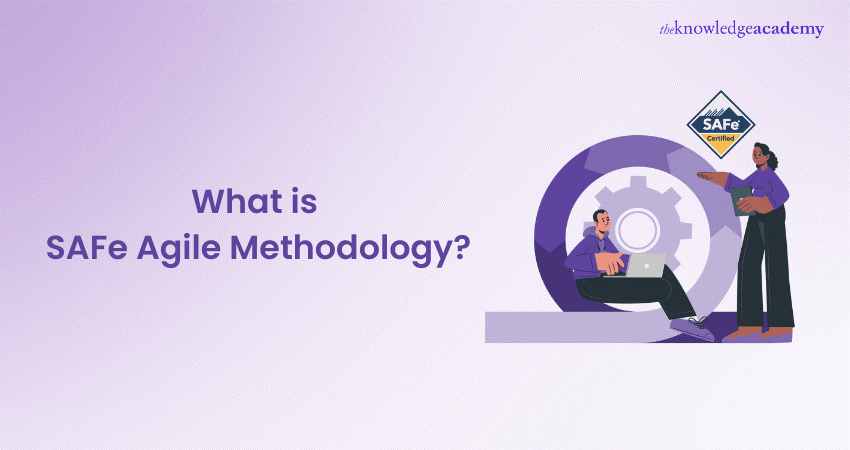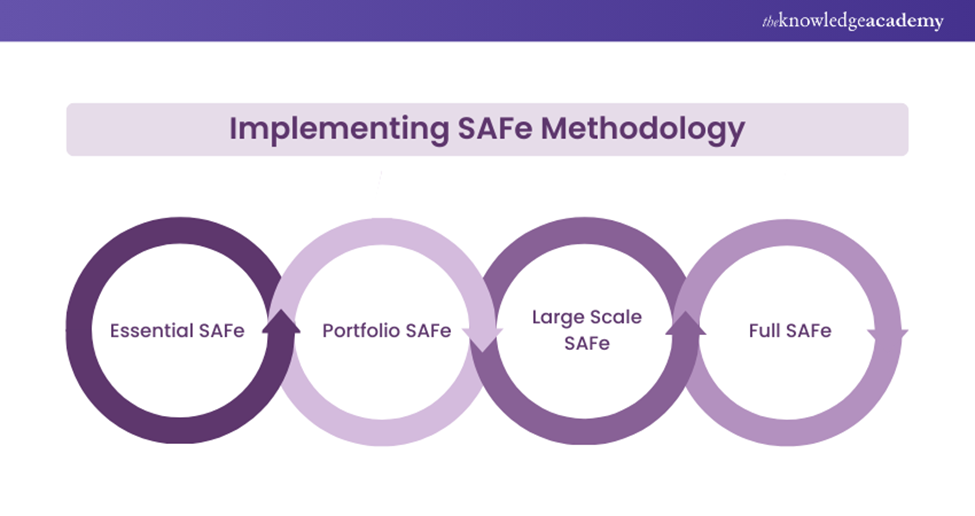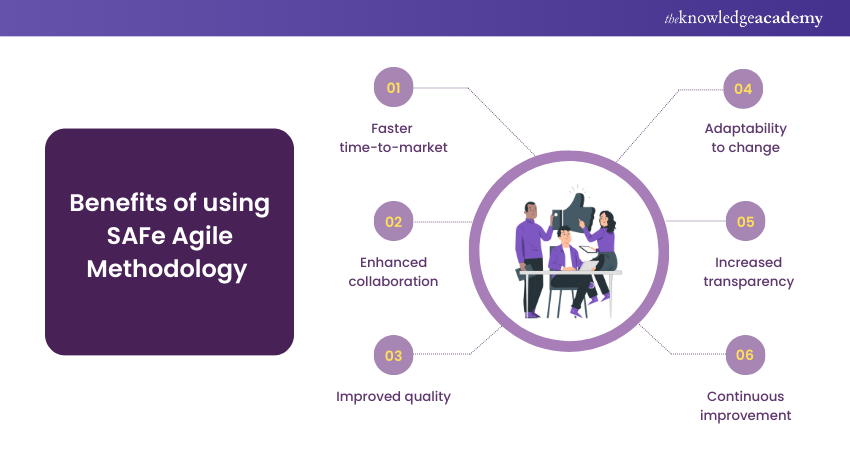We may not have the course you’re looking for. If you enquire or give us a call on +44 1344 203999 and speak to our training experts, we may still be able to help with your training requirements.
Training Outcomes Within Your Budget!
We ensure quality, budget-alignment, and timely delivery by our expert instructors.

In the fast-paced world of Software Development, organisations are constantly seeking efficient and adaptable approaches to manage complex projects. Especially when it comes to large-scale projects involving multiple teams, a different framework is required to ensure seamless coordination and alignment. This is where SAFe Agile Methodology steps in.
Today, Scaled Agile Framework (SAFe) has become one of the top choices of most organisations seeking to align their Project Management processes. It is evident from the 16th State of Agile Report, which states that the most popular framework among organisations is SAFe, with a usage of 53% in 2022.
But if your organisation hasn’t implemented the SAFe Methodology yet, what are you waiting for? It is time to align your Project Management processes with business goals. Don’t know what is SAFe? What are its principles, and how to implement them? Read this blog to know what is SAFe Agile Methodology. Also, learn about how this Agile framework is implemented across large organisations.
Table of Contents
1) What is SAFe Agile Methodology?
2) Principles and core values of SAFe Methodology
3) SAFe Agile methodology competencies
4) Implementing SAFe Methodology
5) Benefits of using SAFe Agile Methodology
6) Conclusion
What is SAFe Agile Methodology?
SAFe Agile Methodology, also known as SAFe, is a scalable and structured Agile Project Management Framework that enables organisations to implement Agile practices across multiple teams, programs, and portfolios. It combines principles from Agile development, Lean thinking, and systems thinking to create a comprehensive approach to managing complex projects.
At its core, this Methodology focuses on fostering collaboration, promoting transparency, and ensuring alignment among teams. It provides various principles, practices, and guidelines that allow organisations to coordinate and synchronise the efforts of multiple teams. As a result, it enables them to work towards a common goal.
Furthermore, SAFe Agile Methodology provides the flexibility and adaptability required to respond to changing market needs and evolving priorities. It allows organisations to deliver value incrementally. As a result, it ensures improved delivery, customer satisfaction, and product quality. To get a deeper understanding there are different levels of SAFE Framework.

Principles and Core Values of SAFe Agile Methodology
The foundation of the SAFe Methodology is based on certain core values and principles, which makes it easy to adapt and work with. So, let’s have a brief look at both of them:
Core values
The core values of SAFe are as follows:
a) Alignment: Ensures that all teams and stakeholders work towards a common goal. It involves establishing clear objectives, defining a shared vision, and synchronising the efforts of different teams.
b) Built-in quality: It emphasises the importance of incorporating quality practices throughout the development process. By integrating continuous testing, automated builds, and code reviews, organisations can ensure the delivery of high-quality software incrementally.
c) Transparency: SAFe Methodology promotes transparency by providing visibility into the progress, challenges, and dependencies of different teams. This allows for timely identification of issues and facilitates timely resolution.
c) Program execution: Program execution focuses on efficient and synchronised value delivery across multiple teams. It involves regular program-level planning, coordination, and synchronisation.
Principles
Based on these core values, SAFe further incorporates some principles that are applied to the processes during product development. These principles help create a collaborative, transparent, and efficient working environment. So, let’s have a look at the SAFe principles in detail:
a) Take an economic view: This principle emphasises the importance of considering the economic impact of choices and prioritising work based on its value and return on investment. As a result, organisations can optimise resource utilisation and maximise customer satisfaction.
b) Apply systems thinking: SAFe Agile Methodology promotes systems thinking, which means considering the entire value stream and understanding the interdependencies between different components and teams. Organisations can achieve better coordination, collaboration, and overall system performance by taking a holistic view.
c) Assume variability; preserve options: It encourages organisations to embrace variability and maintain flexibility by preserving options. It advocates delaying decisions until the last responsible moment to gather more information and make informed choices. Therefore, organisations can respond effectively to evolving customer needs and market conditions.
d) Build incrementally with fast, integrated learning cycles: This principle of SAFe Agile Methodology encourages organisations to deliver working software in short iterations, gather feedback, and learn from it. By incorporating this principle, organisations can continuously improve their products and processes. As a result, they can come up with higher-quality deliverables and faster time-to-market.
e) Base milestones on goal evaluation of working systems: This principle emphasises the importance of validating progress through working software and real-world results. It helps organisations ensure that the delivered systems meet the desired outcomes and provide value to the stakeholders.
f) Visualise and limit work-in-progress: It helps optimise flow and avoid overburdening teams. This principle further promotes using visual management techniques, such as Kanban boards, to make work visible, identify bottlenecks, and improve collaboration.
Enhance your awareness of the Scrum Framework to boost productivity. Register for our Scrum Certification Training!
SAFe Agile Methodology competencies
There are five main competencies which the SAFe Methodology focuses on to help organisations act according to the dynamic market conditions, customer requirements, and new technologies. These competencies are as follows:
Lean-Agile Leadership
Lean-Agile Leadership is a form of Leadership approach, which helps to combine principles from Lean and Agile methodologies. This combination helps organisations to become more responsive, adaptable, and customer centric. Here are some more aspects associated with Lean-Agile Leadership:
a) The Lean-Agile leaders focus on delivering good value to customers. This is their primary objective. The customer needs are prioritised to eliminate any extra or non-value-added activities from their progress.
b) These leaders follow the concept of continuous improvement called Kaizen. It helps in encouraging their teams to reflect regularly on their processes and be more effective and efficient.
c) This Leadership draws heavily from the Lean principles, such as minimising activities which produce no results, optimise flow, and focus on value stream mapping. They reduce lead times, streamline processes and improve the resource allocation.
d) Lean-Agile Leadership when combined with the SAFe framework, results in a set of roles, practices, and activities that help organisations to scale Agile practices to large teams and portfolios.
e) The Lean-Agile leaders develop principles and practices, team coaching and other organisational practices which brings in effective leadership for the organisation.
Technical agility
When SAFe Methodology is applied in a Lean-Agile leadership, a necessity to understand the importance of nurturing the technical excellence within Agile teams automatically develops.
These technical teams have the responsibility to deliver high-quality work to build better relationships with customers. These teams need to perfect their technical knowledge as there is a constant change and development in the technical world.
These teams are also responsible to ensure that the tests that are conducted for various purposes are practical and functional. This not only improves the quality of work, but also creates a culture of accountability and validation among the team members. They also consider various factors to improve their work and structure, so that it reduces the technical debt over time.
Lean portfolio management
To implement the SAFe Methodology, there must be an extensively researched strategy for that organisation. There should also be a frequent inspection and adaptation which would help organisations to respond quickly to the changing market conditions and various customer needs.
This Lean portfolio management incorporates both Agile and Lean principles. This portfolio management also organises work into Agile Train Releases (ARTs). These are teams which helps in coordination and aligns work across the portfolio.
Business solutions
It is one of the critical competencies of SAFe. It focuses on aligning business strategy with Agile development and delivery practices. These practices help in creating valuable solutions for customers and ensure that the organisation can efficiently deliver solutions.
This competency emphasises the importance of aligning organisation’s strategic objectives with the solutions that are being developed. This also encourages the use of value stream mapping, which helps in identifying end-to-end workflows and value streams within the organisation.
DevOps on demand
Even though DevOps on demand is not a primary competency within SAFe, companies customise and extend SAFe to suit their needs. DevOps on demand emphasises on fostering DevOps culture within the organisation.
It includes promoting collaboration, transparency, and shared responsibility between development and operation teams. This shared responsibility helps in streamlining the delivery pipeline. It also focuses on implementing Continuous Integration/Continuous Delivery (CI/CD) which helps in integration of code changes and the automated delivery of software to production environments. Moreover, it promotes the use of infrastructure as code to provision and manage infrastructure resources. This allows for more consistent and repeatable infrastructure deployments.
Stay protected with Safe 6.0! Upgrade now for advanced security features.
Implementing SAFe Methodology
The SAFe Methodology can be implemented across multiple development environments. It includes four different setups that can be tailored to meet the specific needs and context of an organisation.
These setups guide SAFe professionals on how to structure teams, coordinate work, and manage dependencies to scale Agile practices at the enterprise level effectively. They also offer flexibility and options for organisations to choose the most suitable setup based on project size, complexity, and organisational structure. Let’s have a look at these implementation setups:

1) Essential SAFe
Essential SAFe is the basic configuration of SAFe and serves as a starting point for organisations transitioning to Agile practices. It focuses on the essential elements of agile development, such as Agile Release Trains (ARTs), Iterations, and the Agile Team. This configuration also provides the core framework for Agile delivery and sets the foundation for scaling agility across teams and projects.
2) Portfolio SAFe
Portfolio SAFe focuses on strategic alignment and investment decision-making. It guides organisations in managing a portfolio of projects and initiatives. This configuration helps prioritise work, allocate resources, and ensure that strategic goals are achieved through effective portfolio management. As a result, it enables organisations to make informed investment decisions based on economic value and strategic objectives.
3) Large Scale SAFe
Large Scale SAFe is designed for organisations working on complex projects that require multiple ARTs to collaborate and deliver a large solution. It provides additional guidance for managing large-scale initiatives and addressing coordination and alignment challenges across teams and programs. Therefore, this configuration helps organisations effectively manage dependencies, synchronise efforts, and deliver complex solutions in a coordinated manner.
4) Full SAFe
Full SAFe is the most comprehensive configuration of SAFe. It is suitable for large enterprises with multiple value streams and a significant number of development teams. It combines Essential, Large Scale, and Portfolio SAFe, providing a holistic approach to scaling agility across the entire organisation. This configuration addresses the challenges of managing multiple value streams, aligning strategies, and optimising resources at an enterprise level.
Benefits of using SAFe Agile Methodology
This Methodology offers numerous benefits for organisations that adopt and implement it effectively. Let’s explore some of the benefits of the SAFe Methodology:

a) Faster time-to-market: SAFe Agile Methodology enables organisations to deliver value more frequently and efficiently. By breaking down large projects into manageable increments and providing a structured approach to planning and execution, it reduces time-to-market.
b) Enhanced collaboration: The Methodology promotes collaboration and teamwork across different teams and departments. It establishes clear roles, responsibilities, and communication channels. Therefore, it helps organisations foster a collaborative and collective ownership culture.
c) Improved quality: Quality is an integral part of SAFe. It integrates quality practices, such as continuous testing and code reviews, throughout the development process. As a result, organisations can ensure that the software meets the desired standards and requirements.
d) Adaptability to change: SAFe Agile Methodology embraces change and provides a flexible framework for managing evolving requirements. This Methodology helps in regularly reviewing and reprioritising the backlog. Therefore, organisations can adapt to changing market conditions, customer feedback, and business needs. This also allows organisations to stay ahead of the competition and deliver products that meet current market demands.
e) Increased transparency: The Methodology promotes transparency by providing visibility into project progress, challenges, and dependencies. This transparency enables stakeholders to understand the project status, facilitating better decision-making clearly.
f) Efficient resource utilisation: By aligning teams and prioritising work based on value and dependencies, SAFe Agile Methodology allows organisations to ensure that resources are allocated effectively. This leads to improved productivity, reduced free time, and enhanced utilisation of available talent and expertise.
g) Continuous improvement: SAFe also encourages teams to reflect on their processes regularly, identify areas for improvement, and experiment with new approaches. This helps organisations to refine their practices, enhance productivity, and deliver better outcomes over time.
Conclusion
Safe Agile Methodology provides organisations with a structured and scalable framework for implementing Agile Processes at an enterprise level. By embracing this methodology, organisations can achieve higher productivity levels, customer satisfaction, and success in today’s dynamic business environment.
Gain skills to lead Agile transformations and drive organisational success with our Certified Scaled Agile Framework Leading SAFe® 6.0 Training And Exam.
Frequently Asked Questions

The Full SAFe configuration is one of the most comprehensive configurations that includes all seven core competencies for business agility. This Full SAFe in Agile is used by very large organisations to maintain portfolios of large and complex solutions.

The following are some primary goals of SAFe Agile:
a) Team and technical agility
b) Enterprise solution delivery
c) Lean portfolio management
d) Organisational agility
e) Agile product delivery
f) Lean Agile leadership

SAFe Agile presents with the challenge of maintaining co-ordination and collaboration across all teams, when scaling Agile in large organisations. To combat this, organisations invest a large amount of money in training and education programs which helps everyone to be on the same page and work towards the same goal of the organisation.

The Knowledge Academy takes global learning to new heights, offering over 30,000 online courses across 490+ locations in 220 countries. This expansive reach ensures accessibility and convenience for learners worldwide.
Alongside our diverse Online Course Catalogue, encompassing 17 major categories, we go the extra mile by providing a plethora of free educational Online Resources like News updates, Blogs, videos, webinars, and interview questions. Tailoring learning experiences further, professionals can maximise value with customisable Course Bundles of TKA.

The Knowledge Academy offers various Agile courses, including Certified Scaled Agile Framework Leading SAFe® 6.0 Training and Exam, Agile Project Management Foundation & Practitioner (AgilePM®), and Certified Professional In Agile Project Management (CPAPM). These courses cater to different skill levels, providing comprehensive insights into Agile methodologies.
Our Agile Training blogs covers a range of topics related to Agile, offering valuable resources, best practices, and industry insights. Whether you are a beginner or looking to advance your Agile skills, The Knowledge Academy's diverse courses and informative blogs have you covered.
Upcoming Project Management Resources Batches & Dates
Date
 Certified Scaled Agile Framework Leading SAFe® 6.0 Training and Exam
Certified Scaled Agile Framework Leading SAFe® 6.0 Training and Exam
Mon 16th Dec 2024
Sat 21st Dec 2024
Mon 13th Jan 2025
Sat 18th Jan 2025
Sat 22nd Feb 2025
Mon 10th Mar 2025
Sat 22nd Mar 2025
Sat 19th Apr 2025
Sat 17th May 2025
Mon 19th May 2025
Sat 21st Jun 2025
Mon 30th Jun 2025
Sat 19th Jul 2025
Sat 23rd Aug 2025
Mon 25th Aug 2025
Sat 20th Sep 2025
Sat 18th Oct 2025
Sat 22nd Nov 2025
Mon 15th Dec 2025
Sat 20th Dec 2025







 Top Rated Course
Top Rated Course



 If you wish to make any changes to your course, please
If you wish to make any changes to your course, please


